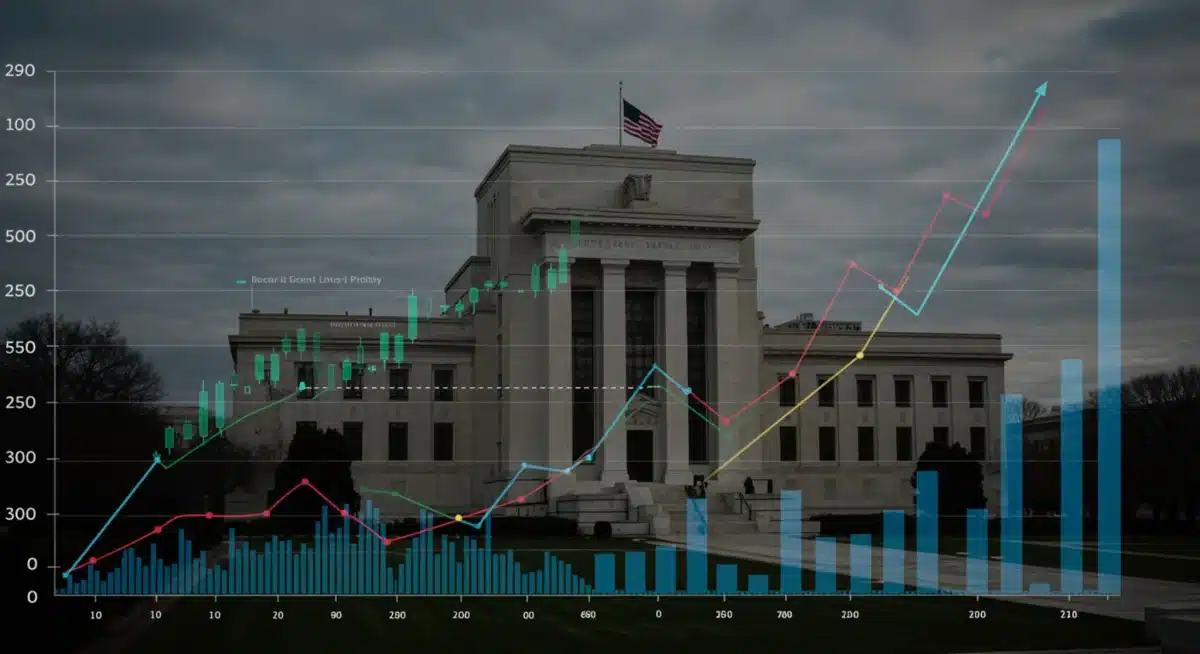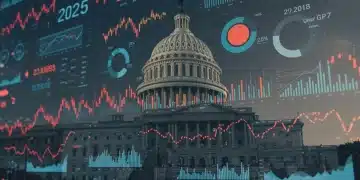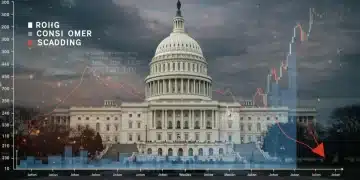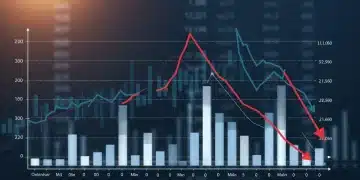US GDP Analysis: Soft Landing or Economic Turbulence Ahead?

The recent US GDP figures provide crucial insights into the nation’s economic trajectory, indicating whether a delicate balance between growth and inflation is leading to a soft landing or signaling potential instability.
Analyzing the latest GDP figures: Is the US economy heading for a soft landing? This question is at the forefront of economists’ minds and directly impacts every American’s financial well-being. Understanding the nuances of Gross Domestic Product (GDP) reports is essential for deciphering the health of the nation and anticipating future economic trends.
Understanding Gross Domestic Product (GDP)
Gross Domestic Product, or GDP, represents the total monetary value of all finished goods and services produced within a country’s borders in a specific time period. It is the broadest quantitative measure of a nation’s economic activity and serves as a fundamental gauge of its overall health. When economists discuss the state of the economy, GDP is often the first metric they examine.
GDP is typically calculated on an annual basis, but it is also released quarterly, providing more frequent snapshots of economic performance. These quarterly reports are often annualized to allow for easier comparison with annual rates. The components of GDP include consumer spending, business investment, government spending, and net exports (exports minus imports).
The Four Pillars of GDP Calculation
To fully grasp what the latest GDP figures signify, it’s crucial to understand its constituent parts. Each component offers a unique perspective on economic activity and can indicate different strengths or weaknesses within the economy.
- Consumer Spending (C): This is often the largest component of GDP, reflecting household expenditures on goods and services. A robust increase here typically signals consumer confidence and economic vitality.
- Business Investment (I): This includes purchases by businesses of capital goods, construction of new buildings, and changes in inventories. It’s a forward-looking indicator, as businesses invest when they anticipate future demand.
- Government Spending (G): Expenditures by federal, state, and local governments on goods and services, such as defense, infrastructure, and public services, contribute directly to GDP.
- Net Exports (NX): This is the difference between a country’s exports and imports. A positive net export value adds to GDP, while a negative value (trade deficit) subtracts from it.
Each of these pillars provides a lens through which to view economic performance. For instance, a surge in consumer spending might offset a decline in business investment, leading to a mixed signal in the overall GDP number. Understanding these interactions is key to a nuanced interpretation of economic data.
Real vs. Nominal GDP
When analyzing GDP figures, it’s vital to distinguish between nominal GDP and real GDP. Nominal GDP measures economic output using current prices, which means it can be inflated by rising prices (inflation). Real GDP, on the other hand, adjusts for inflation, providing a more accurate picture of actual economic growth.
Most economists and policymakers focus on real GDP because it reflects the actual increase in the production of goods and services, rather than just an increase in their price. A high nominal GDP growth rate might sound impressive, but if inflation is equally high, real economic growth could be stagnant or even negative. This distinction is particularly relevant in periods of significant price changes, such as those experienced recently.
In essence, GDP provides a comprehensive but complex picture of economic health. A holistic understanding requires examining its components, adjusting for inflation, and considering the prevailing economic context. These fundamental insights lay the groundwork for interpreting whether the US economy is indeed heading toward a soft landing.
Recent US GDP Performance: A Closer Look
The latest GDP reports have been a focal point for economists, investors, and policymakers alike, offering critical clues about the trajectory of the US economy. Recent figures have shown resilience, often surprising many who anticipated a sharper slowdown. This unexpected strength has fueled the debate around the possibility of a soft landing, a scenario where inflation cools without a significant economic downturn.
Examining the quarterly GDP growth rates provides a detailed narrative. While some quarters have shown robust expansion, others have indicated a moderation, reflecting the impact of tighter monetary policy and various global headwinds. These fluctuations are not unusual, but their underlying causes and potential implications for future growth are what truly matter.
Key Drivers of Recent Growth
Several factors have contributed to the recent GDP performance. Consumer spending has remained remarkably strong, driven by a resilient labor market and, in some cases, accumulated savings from the pandemic era. This continued willingness of consumers to spend has acted as a significant buffer against potential contractions.
Furthermore, government spending, particularly on infrastructure projects and other initiatives, has also provided a boost. While business investment has shown some variability, certain sectors have continued to expand, contributing positively to the overall economic output. The services sector, in particular, has demonstrated consistent strength, compensating for some slowdowns in manufacturing.
Challenges and Headwinds
Despite the positive aspects, the US economy faces notable challenges. High interest rates, implemented by the Federal Reserve to combat inflation, have begun to weigh on certain sectors, particularly housing and interest-sensitive investments. These higher borrowing costs can stifle business expansion and consumer borrowing, potentially slowing future growth.
Global economic uncertainties, including geopolitical tensions and supply chain disruptions, also pose a risk. While the US economy has proven relatively insulated from some of these external shocks, they can still impact trade, investment, and overall confidence. The interplay of these internal and external factors makes predicting the economic future a complex endeavor.
In summary, the recent GDP performance paints a picture of an economy grappling with competing forces. Strong consumer demand and targeted government spending have provided significant support, even as elevated interest rates and global instability present ongoing challenges. These dynamics are central to the discussion of whether a soft landing is achievable.
Defining a Soft Landing in Economic Terms
The concept of a “soft landing” has become a buzzword in economic discussions, particularly as central banks worldwide grapple with inflation. In simple terms, a soft landing refers to a situation where a central bank successfully raises interest rates to curb inflation without triggering a severe economic recession. It’s a delicate balancing act, aiming to cool down an overheated economy just enough to bring prices under control, but not so much that it leads to widespread job losses and a significant contraction.
Achieving a soft landing is widely considered the ideal outcome when an economy experiences high inflation. It avoids the painful consequences of a recession, such as mass unemployment, business failures, and a prolonged period of economic stagnation. Historically, however, successful soft landings have been relatively rare, making the current economic environment a subject of intense scrutiny.
Key Indicators of a Soft Landing
Several economic indicators are closely monitored to assess whether a soft landing is underway. These metrics provide insights into the labor market, inflation trends, and overall economic activity, helping economists determine if the economy is decelerating gracefully rather than crashing.
- Declining Inflation: The most crucial sign is a sustained reduction in the rate of inflation, moving towards the central bank’s target (e.g., 2% for the Federal Reserve) without a sharp increase in unemployment.
- Stable Employment: While some cooling in the labor market is expected, a soft landing implies that unemployment rates remain relatively low, avoiding a significant spike in job losses.
- Moderate Economic Growth: GDP growth may slow down from peak levels but should remain positive, indicating that the economy is still expanding, albeit at a more sustainable pace.
- Consumer Confidence: Maintaining relatively stable consumer confidence suggests that households are not overly pessimistic about future economic conditions, which helps sustain spending.
These indicators collectively paint a picture of an economy that is adjusting to new monetary policy realities without experiencing severe distress. The challenge lies in interpreting these signals accurately, as economic data can often be noisy and subject to revision.
The Alternative: A Hard Landing
The opposite of a soft landing is a “hard landing,” which signifies a significant economic downturn or recession. This occurs when aggressive monetary tightening, or other economic shocks, leads to a sharp contraction in economic activity, often characterized by a rapid increase in unemployment, widespread business failures, and a decline in consumer spending.
A hard landing is generally what central banks strive to avoid, as its social and economic costs can be substantial and long-lasting. The current debate about the US economy largely revolves around whether policymakers can navigate the challenges to achieve the desired soft landing, or if a hard landing is an inevitable consequence of the recent inflationary pressures and subsequent policy responses.
Ultimately, a soft landing represents a triumph of economic policy, demonstrating the ability to manage complex economic forces effectively. The ongoing analysis of GDP figures and other key metrics aims to determine if the US economy is on such a path.
The Role of Inflation and Interest Rates
Inflation and interest rates are inextricably linked and play a pivotal role in determining the US economy’s trajectory, particularly in the context of achieving a soft landing. The Federal Reserve, as the nation’s central bank, wields the primary tool for influencing these factors: monetary policy. Its decisions directly impact borrowing costs, consumer spending, and business investment, thereby shaping the overall economic landscape.
For the past couple of years, elevated inflation has been a dominant concern, prompting the Federal Reserve to embark on a series of aggressive interest rate hikes. The goal of these hikes is to cool down aggregate demand, making borrowing more expensive and thus discouraging spending and investment. This reduction in demand is intended to bring prices back down to the Fed’s target of 2% inflation.
Federal Reserve’s Monetary Policy Toolkit
The Federal Reserve primarily uses the federal funds rate as its key policy instrument. By raising this target rate, the Fed influences other interest rates throughout the economy, from mortgage rates to business loan rates. Higher rates mean it costs more for consumers to borrow for homes or cars, and for businesses to finance expansion, which in turn slows economic activity.
- Interest Rate Hikes: The primary tool to combat inflation by increasing the cost of borrowing and reducing demand.
- Quantitative Tightening: Reducing the size of the Fed’s balance sheet by letting bonds mature without reinvesting, which further drains liquidity from the financial system.
- Forward Guidance: Communicating future policy intentions to manage market expectations and influence long-term interest rates.
The effectiveness of these tools in engineering a soft landing depends on various factors, including the responsiveness of the economy to rate changes and the underlying causes of inflation. If inflation is primarily supply-driven, monetary policy might be less effective and carry higher risks of over-tightening.
The Tightrope Walk: Balancing Inflation and Growth
The challenge for the Federal Reserve is to raise interest rates just enough to subdue inflation without pushing the economy into a recession. This is often referred to as a “tightrope walk” because the optimal level of tightening is rarely clear in real-time. Too little tightening, and inflation could become entrenched; too much, and economic activity could contract sharply.
Recent GDP figures, alongside inflation data such as the Consumer Price Index (CPI) and the Personal Consumption Expenditures (PCE) price index, are crucial for the Fed’s decision-making process. They assess whether their policies are having the desired effect on prices without causing undue harm to employment and economic growth. The ongoing analysis of these data points will dictate future policy adjustments.
In conclusion, the interplay between inflation and interest rates is central to the soft landing narrative. The Federal Reserve’s precise calibration of monetary policy, guided by economic data like GDP, is arguably the most significant factor in determining the US economy’s ability to navigate current challenges successfully.

Labor Market Dynamics and Consumer Behavior
The health of the labor market and the resilience of consumer behavior are two critical pillars supporting the US economy’s quest for a soft landing. A strong job market provides the income necessary for consumer spending, which is the largest component of GDP. Conversely, any significant weakening in employment could quickly undermine economic stability and derail efforts to achieve a gentle deceleration.
Recent labor market data has shown remarkable strength, with unemployment rates remaining historically low and wage growth, while moderating, still providing a boost to household incomes. This robust employment picture has been a key factor in preventing a more severe economic slowdown, even as interest rates have risen.
Key Labor Market Indicators
Several indicators offer insights into the state of the labor market and its implications for consumer behavior. These include the unemployment rate, job creation numbers, wage growth, and labor force participation. Each metric tells a part of the story, and together they form a comprehensive view.
- Unemployment Rate: A low unemployment rate generally indicates a healthy labor market, where most individuals seeking employment can find it.
- Non-Farm Payrolls: The monthly report on new jobs created provides a timely measure of hiring activity and economic expansion.
- Wage Growth: While essential for consumer purchasing power, excessive wage growth can contribute to inflationary pressures, making its moderation a desirable outcome for a soft landing.
- Labor Force Participation Rate: This indicates the proportion of the working-age population that is either employed or actively looking for work, reflecting the overall engagement in the labor market.
The Federal Reserve closely monitors these indicators, aiming for a rebalancing of the labor market where job openings align more closely with available workers, reducing upward pressure on wages without causing widespread job losses. This “cooling” without freezing is central to a soft landing.
Consumer Spending Trends
Consumer spending comprises roughly two-thirds of US GDP, making its trajectory paramount. Despite inflationary pressures and higher interest rates, consumers have largely continued to spend, albeit with some shifts in patterns. Expenditures on services have remained strong, while spending on some durable goods has seen a slowdown.
Factors influencing consumer spending include real disposable income, consumer confidence levels, and household balance sheets. While some households have drawn down pandemic-era savings, others still possess a buffer. The sustained strength in the labor market provides ongoing income, which remains a primary driver of consumer outlays.
In conclusion, the interplay of a resilient labor market and adaptable consumer behavior is crucial for achieving a soft landing. As long as Americans feel secure in their jobs and have sufficient income, the economy has a better chance of navigating inflationary pressures without succumbing to a deep recession.
Global Economic Factors and US Outlook
The US economy does not operate in a vacuum; global economic factors exert significant influence on its performance and the likelihood of achieving a soft landing. Interconnectedness through trade, investment, and financial markets means that developments abroad can quickly reverberate through the domestic economy. Understanding these external forces is therefore essential for a comprehensive outlook.
Recent global challenges, including geopolitical conflicts, energy price volatility, and varying economic performances among major trading partners, have added layers of complexity to the US economic picture. While the US economy is relatively large and diversified, it remains susceptible to these international currents.
Impact of International Trade and Supply Chains
International trade plays a direct role in US GDP through net exports. A slowdown in global demand can reduce US exports, while disruptions to global supply chains can increase import costs and contribute to domestic inflation. The recent emphasis on reshoring and diversifying supply chains aims to mitigate some of these vulnerabilities, but the process is gradual.
- Global Demand: Weaker economic growth in major economies like Europe or China can dampen demand for US goods and services, affecting export volumes.
- Supply Chain Resilience: Ongoing efforts to build more robust supply chains can reduce inflationary pressures stemming from disruptions but require significant investment and time.
- Currency Fluctuations: The strength of the US dollar can impact the competitiveness of US exports and the cost of imports, influencing trade balances.
These trade dynamics are constantly evolving, and their impact on US economic growth and inflation must be continuously assessed. A favorable global trade environment can provide an additional tailwind, whereas significant disruptions can act as a drag.
Geopolitical Risks and Energy Markets
Geopolitical tensions, particularly in energy-producing regions, can have a profound impact on global commodity prices, especially oil and natural gas. Spikes in energy prices feed directly into inflation, increasing costs for businesses and consumers alike. This can complicate the Federal Reserve’s efforts to manage inflation and steer the economy towards a soft landing.
Furthermore, geopolitical instability can deter international investment and create uncertainty, leading to cautious behavior among businesses and consumers. While the US is a significant energy producer, it is not entirely immune to global energy market volatility, which can quickly translate into higher domestic prices and reduced purchasing power.
In conclusion, the US economic outlook is not solely determined by domestic policy and conditions. Global economic health, trade relations, and geopolitical stability are crucial external factors that can either support or hinder the path to a soft landing. Monitoring these international developments is vital for a complete understanding of the US economy’s future.
Future Projections and Potential Scenarios
Forecasting the future of the US economy, especially regarding the prospect of a soft landing, involves analyzing current trends, understanding policy responses, and considering various potential scenarios. While the latest GDP figures offer a snapshot, sustained economic health depends on how these trends evolve and how policymakers react to emerging challenges. Economists and financial institutions regularly update their projections, often presenting a range of possibilities given the inherent uncertainties.
The most optimistic scenario envisions a successful soft landing, where inflation gradually returns to the Federal Reserve’s target without a significant increase in unemployment or a recession. This outcome would be a testament to effective monetary policy and the underlying resilience of the US economy. However, other scenarios, including a mild recession or prolonged stagflation, cannot be entirely ruled out.
The Optimistic Soft Landing Path
Under a soft landing scenario, several conditions would likely materialize. Inflationary pressures would continue to ease, driven by both supply-side improvements and the cumulative effect of higher interest rates. The labor market would gradually rebalance, with job openings declining and wage growth moderating, but without a sharp rise in the unemployment rate. Consumer spending would remain positive, albeit growing at a more sustainable pace, supported by real wage gains.
Business investment would pick up as economic uncertainty diminishes, and global economic conditions would either stabilize or improve, providing a favorable backdrop for US exports. In this scenario, the Federal Reserve would eventually be able to pause or even begin to cut interest rates, signaling a return to more normalized monetary policy.
Risks and Alternative Scenarios
Despite the hopes for a soft landing, several risks could push the economy towards less favorable outcomes. A key risk is that inflation proves more persistent than anticipated, forcing the Federal Reserve to maintain higher interest rates for longer or even implement further hikes. This could lead to an over-tightening of monetary policy, triggering a recession (a “hard landing”).
Another risk involves unexpected external shocks, such as new geopolitical conflicts, severe supply chain disruptions, or a significant downturn in a major global economy. Such events could quickly undermine domestic stability. Furthermore, if consumer confidence erodes significantly or the labor market weakens more rapidly than expected, a self-reinforcing cycle of reduced spending and investment could lead to a downturn.

Monitoring Key Indicators
To navigate these potential scenarios, continuous monitoring of key economic indicators is paramount. Beyond GDP, attention will remain focused on inflation metrics (CPI, PCE), labor market data (unemployment claims, job openings), consumer sentiment surveys, and global economic health reports. These data points will collectively inform whether the US economy is successfully charting a course toward a soft landing or if it faces a bumpier ride ahead.
In conclusion, while recent GDP figures offer a glimmer of hope for a soft landing, the path forward is complex and fraught with potential challenges. A successful outcome will depend on a delicate interplay of domestic policy, consumer and business behavior, and evolving global dynamics.
| Key Point | Brief Description |
|---|---|
| GDP Resilience | Recent US GDP figures show unexpected strength, fueling soft landing hopes despite high interest rates. |
| Soft Landing Definition | Achieving lower inflation without triggering a recession, a delicate balance for central banks. |
| Inflation & Rates | Federal Reserve’s interest rate hikes aim to curb inflation, impacting borrowing and economic activity. |
| Labor Market Strength | A robust job market and consumer spending are key buffers against economic downturns, supporting growth. |
Frequently Asked Questions About the US Economic Outlook
For the average American, a soft landing means that inflation cools down, making everyday goods and services more affordable, without a significant increase in unemployment. It implies economic stability, continued job security, and a generally healthy environment for personal finances, avoiding the hardships associated with a recession.
Recent GDP figures provide crucial data on economic growth, directly influencing the Federal Reserve’s monetary policy. Stronger-than-expected GDP might give the Fed more room to maintain higher interest rates to combat inflation, while a significant slowdown could prompt them to consider pausing or even cutting rates to support economic activity.
The biggest risks to a US soft landing include persistent inflation that forces more aggressive Fed tightening, unexpected geopolitical shocks impacting energy or supply chains, and a rapid erosion of consumer confidence leading to a sharp drop in spending. Any of these could tip the economy into a recession.
Yes, a recession remains a possibility, though recent data has reduced its immediate likelihood. While a soft landing is the desired outcome, the Federal Reserve’s fight against inflation still carries the risk of over-tightening. Economic forecasts often include a range of scenarios, with a mild recession being one of the less optimistic possibilities.
Consumer spending is vital to the soft landing debate because it accounts for a large portion of US GDP. Continued robust spending, supported by a strong labor market, helps sustain economic growth even as other sectors might slow. A significant drop in consumer confidence and spending could quickly accelerate an economic downturn.
Conclusion
The intricate dance between economic growth, inflation, and monetary policy continues to define the US economic landscape. Analyzing the latest GDP figures: Is the US economy heading for a soft landing? The answer remains cautiously optimistic, largely supported by resilient consumer spending and a robust labor market. While significant challenges persist, including the ongoing battle against inflation and global uncertainties, the data suggests a path where the economy might decelerate gracefully rather than abruptly. The Federal Reserve’s careful navigation of interest rates, coupled with the inherent adaptability of American businesses and consumers, will ultimately determine whether this delicate balance can be maintained, guiding the nation towards sustained stability without succumbing to a deeper downturn.





